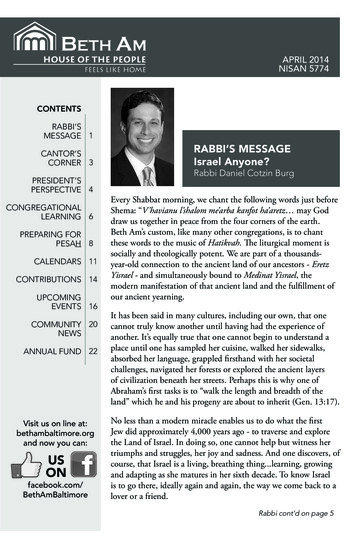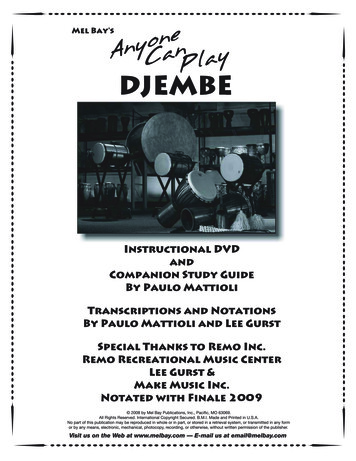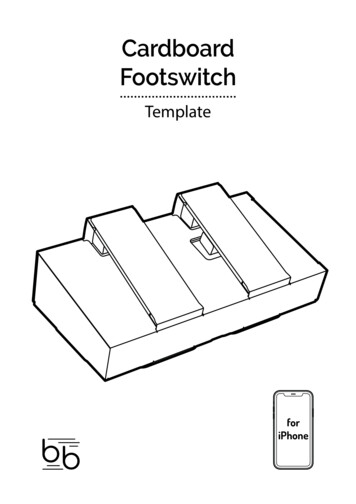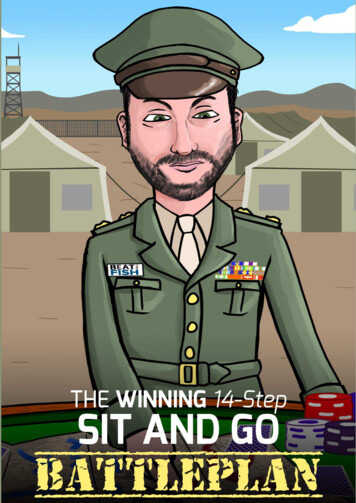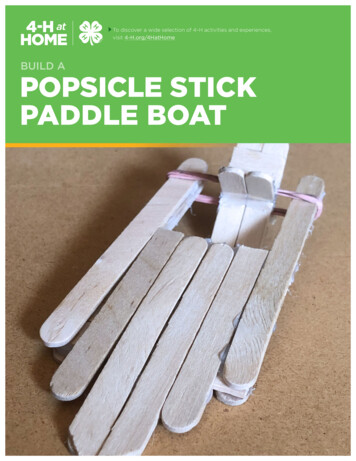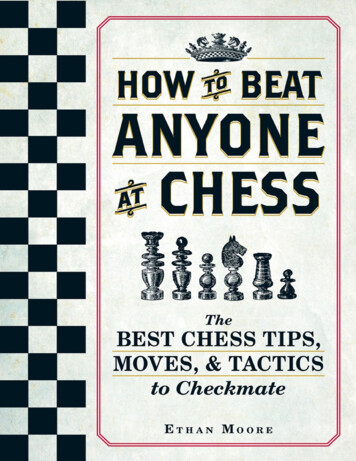
Transcription
HOW TO BEATANYONEAT CHESSTheBEST CHESS TIPS, MOVES, &TACTICS to CheckmateETHAN MOOREAvon, Massachusetts
ContentsIntroductionPreface Where Did It Come From?PART I THE BASICSChapter 1 The Board and the PiecesChapter 2 The Object of the GameChapter 3 En Passant and Other Special MovesChapter 4 Notation—Keeping Track of Your GamePART II BEATING YOUR OPPONENTChapter 5 The Basics of Strategy in a Chess GameChapter 6 The Importance of the OpeningChapter 7 Special AttacksChapter 8 The Next Few MovesChapter 9 Build Your Arsenal of Chess TacticsChapter 10 Dominating the EndgamePART III THE AMAZING WORLD OF CHESSChapter 11 The World of Competitive ChessChapter 12 Famous Matches and PlayersAppendix A Computerized Chess and Online ResourcesAppendix B Glossary
IntroductionIT LOOKS SIMPLE.A board with sixty-four squares of alternating colors. Thirty-two pieces—sixteen pawns, four rooks, four knights, four bishops, and two kingsand queens. Two armies facing one another, poised for combat.It looks simple. And yet . . .For more than 1,500 years, players have faced one another across thechessboard and fought for victory. As for complexity—well, there aremore than 300 billion possible ways to play the first four moves of thegame. When you consider the possible combinations of the first tenmoves, that number rises to an Clearly there is a lot more chess to be played.Chess appeals to people from every part of the globe and in every walkof life. It’s been a favorite of kings and queens, of presidents andpoliticians, as well as of people you meet every day. Today you can findchess players in coffee shops, college dorms, and bars. You can playagainst someone sitting opposite you or you can battle it out with a playerin front of her computer half a world away. You can practice your chessgame using an app on your smartphone or laptop. You can play a friendlygame with your buddy or challenge yourself and your opponent in a highstakes timed competition. (There have even been players like thelegendary Bobby Fischer, who could play an entire chess game in his headwithout board or pieces in front of him.)
Chess sets themselves can be dazzling works of art, their pieces shapedlike anything from jewel-encrusted, medieval kings and queens to Homerand Marge Simpson.Within this book you’ll find out more about the remarkable story of thisgame. As well, you’ll learn the basic moves and some points of chessstrategy and tactics. (Hint: Control the center of the board!) You’lldiscover the biographies of some of the people who have become mastersof chess. Finally, you’ll get a glimpse into the world of organized chessand find out how you can become part of it.Chess is warfare without bloodshed. It’s one of the best ways everdiscovered to sharpen your mind and broaden your experience.Your move!
PREFACEWhere Did It Come From?DETERMINING THE ORIGIN OF CHESS can be problematic becausethe game was not invented out of whole cloth. Rather, it evolved over along time. Its earliest clear ancestor was a game called chatrang, whichemerged in Persia between the fifth and sixth centuries, although someargue that the game’s roots lie even further back, perhaps as early as thethird century.Chatrang used a sixty-four-square gameboard with thirty-two pieces.Among these pieces were a king, a minister (later replaced by today’squeen), two elephants (in place of today’s bishops), two horses, and tworuhks, the Persian word for “chariots.” There were also eight footsoldiers.Chatrang spread across Europe, probably carried along the Silk Road,the network of trade routes that stretched from China to theMediterranean Sea. Along the way, the movement of some of the piecesgradually changed. The object of the game evolved from what today wewould call stalemate to the modern checkmate.The greatest change occurred during the eleventh and twelfth centurieswhen the minister or vizier was replaced by the queen, which during thenext several centuries became the most powerful piece on the board.Some researchers have speculated that this change reflected the strongpolitical role played by many medieval queens.Once it was firmly established, chess began to be systematicallystudied. The earliest known chess book was published in 1497: The Art of
Chess by Luis Ramírez Lucena. Somewhat better known is a work by hiscontemporary Ruy López de Segura, who first analyzed the popularopening subsequently named for him.Spanish players may have been among the early superstars of the chessworld, but as the game made its way across Europe other masters arose inFrance, Germany, and Italy. In the nineteenth and twentieth centuries,the center of chess shifted to Russia. Particularly under the Soviets, chessbecame a national sport, heavily subsidized by the government. Chessteams were fielded for international competition and often seemedunbeatable.The man who almost singlehandedly broke the Soviet domination oftwentieth-century chess was Bobby Fischer, considered by many to be thegreatest chess player who ever lived. Fischer, a child prodigy, studied thegame intently, memorizing thousands of openings and variations,perfecting tactics that astounded grandmasters. In 1972 he played the topRussian, Boris Spassky, in what was dubbed the “Match of the Century.”In a titanic struggle of twenty-one games, Fischer won. Sadly, afterreaching the acme of the chess world, Fischer withdrew from society,becoming an often penniless recluse in Southern California and laterabroad. He became an obsessive anti-Semite, his passport was revoked,and he stopped participating in international competition. He died inIceland in 2008.Since Fischer, there have been many great players, such as theRussians Garry Kasparov and Anatoly Karpov. Top chess performersinclude people such as Judit Polgár, the strongest female player inrecorded history, and Magnus Carlsen, the current world champion, whohas an official chess rating of 2876 and had the highest rating everrecorded, at 2882. He is also the third-youngest person ever to become agrandmaster, a feat he accomplished at thirteen (the youngest person todo this was Sergey Karjakin, who became a grandmaster at age twelve).
From its humble origins, chess has spread across the globe. It is truly auniversal game.
PART ITHE BASICS
CHAPTER 1The Board and the PiecesAll right. You’re ready to learn chess. In front of you is the chessboard: asquare divided up into sixty-four smaller, equally sized squaresalternately colored light and dark. Chessboards come in all sorts of sizesand the squares can be almost any color, but most serious players stick toa standard size of about 16–22" per side with 2–21 2" checkered squares.Everyone has sixty-four squares to work with. Half of sixty-four isthirty-two. Therefore, here’s your first rule of strategy: If you controlthirty-three squares, you will have an advantage. Keep this in mind.Here is a diagram of a chessboard. Note the checkered squares, and the light squareat the right-hand corner at the bottom.Light on Right
When setting up the chessboard, always make sure a light square is atyour lower right corner. Your opponent, who sits opposite you, will alsohave a light square at his or her lower right corner. (If you prefer, you canthink of this as a dark square always being at your left; it works just aswell.)WHAT ARE CHESSBOARDS MADE OF?The material of a chessboard can be almost anything.Wood, plastic, paper, cardboard, and vinyl are common. Solong as there are sixty-four alternating light and darksquares, you have a useable board.Using All SquaresIn chess, both players use all the squares of the board. This is in contrastto the many versions of checkers, where each player only uses half thesquares. It also gives special meaning to the appearance of the chessboardin terms of game planning. There are advanced strategies known asweak-color complexes, where a player cannot get sufficient control of thesquares of one particular color. There is even a chess piece that operateson only one color—the bishop.Ranks, Files, and DiagonalsThe squares of the chessboard do not exist in isolation. They touch orintersect at various points, creating roads or highways across the board.Straight rows of such squares are called ranks, files, and diagonals.
RANKSAs you sit at the chessboard, with a light square at your lower right anda dark square at your lower left, there are eight horizontal rows of eightsquares bordering at the sides, stretching from your left to your right.They begin nearest you and wind up nearest your opponent. These rowscover every square on the chessboard, and they are called ranks.Rank NamesEach rank has a name based on how far away it is from you, assumingyou are playing the White pieces and your opponent is playing the Blackpieces. The rank nearest you is called the first rank. The next rank out iscalled the second rank, the next the third rank, and so on until you get tothe rank nearest your opponent, which is the eighth rank. If you areplaying the Black pieces, the rank nearest you is the eighth rank and therank nearest your opponent is the first rank.What Do Ranks Look Like?Each rank contains four light squares and four dark squares, whichnaturally alternate. Each light square borders a dark square, and eachdark square borders a light square.All ranks are not equal. Notice that the first and eighth ranks eachborder only one rank, while all the other ranks border two ranks. Theedge of the board can be a severe restriction in chess, and the first andeighth ranks represent two of those edges.FILESAs you sit at the chessboard, with a light square at your right and adark square at your left, there are eight vertical rows of eight borderingsquares stretching from you to your opponent. These rows line up fromyour left to your right and cover every square of the board. These rows arecalled files.
File NamesEach file has a name beginning with a letter and ending with “file.”Assuming you are ready to play the White pieces, counting from your leftthe files are the a-file, the b-file, the c-file, and on to the file furthest toyour right (the one starting with the light square), which is the h-file.Assuming you are ready to play the Black pieces, counting from yourleft the files are the h-file, the g-file, the f-file, and on to the file furthestto your right (the one starting with the light square), which is the a-file.DiagonalsRanks and files are not the only highways on the chessboard. There arealso the diagonals, which are straight lines made up of individual squaresthat border at the corners rather than at the sides. They extend at anangle rather than straight across or up and down the board.There are three main things that distinguish a diagonal from a rank orfile:1. Diagonals border at the corners rather than at the sides.2. The number of squares in a diagonal varies from two to eight,whereas ranks and files always contain eight squares each.3. Diagonals consist of squares of one color only, whereas ranks andfiles always contain an equal mixture of dark and light squares.Diagonals don’t have simple, easy-to-remember names like ranks andfiles do. But they are sometimes named for the first and last square on thediagonal: The longest dark diagonal can be called the a1–h8 diagonal,while the smallest light-square diagonals can be called the h7–g8diagonal and the a2–b1 diagonal.Border
Diagonals border at the corners rather than at the sides of the squaresthat make them up. This brings up an interesting optical illusion. Look ata chessboard. Consider the a-file and the a1–h8 diagonal. Which islonger?If you answered the diagonal, you were right in a strictly geometricalsense, but wrong in a chess sense. Each row contains eight squares, andthat means they are the same size for the purposes of a chess game. Bythe same token, it might look like the b1–h7 diagonal is longer than the bfile. But actually it is the file that is longer! The b-file, like all files,contains eight squares, whereas the b1–h7 diagonal consists of only sevensquares.Identifying diagonals.SizeThus you can see a very important property of diagonals: They are noteven close to being equal. Diagonals are made up of anywhere from twoto eight squares. There are four diagonals (two dark and two light)containing two, three, four, five, six, and seven squares, while there aretwo long diagonals (one dark and one light) that each contain eightsquares.
ONE-COLOR DIAGONALSThe most important property of diagonals is that they areall made up of squares of one color. Thus diagonals arelimited-access highways compared to ranks and files.HighwaysSo far we have learned about four types of roads on the chessboard. If youseem to remember only three, that’s because you are not distinguishingbetween dark-square and light-square diagonals.Any other highways are mostly ephemeral. Thus you can visualize theroute a1–a2–a3–a4–b5–c6–d7–e8. Since all squares border, it isdefinitely a highway. There are several pieces that could indeed travel thisroute. But it’s actually nothing more than a mixture of the a-file and thea4–e8 diagonal.RECTANGULAR CORNERThere is just one other type of highway that you need to know about.Because it doesn’t involve bordering squares at all, it’s questionablewhether it can even be called a highway. It also has no name. So we willcall it rectangular corner, since that describes the road (or obstaclecourse): Visualize a six-square rectangle anywhere on the chessboard.Now visualize opposite corners of that rectangle. That’s the rectangularcorner. This road is bumpy, perhaps, but it’s one you will get to knowwell.FIVE HIGHWAYSTo review, the five types of chessboard highways are:
RankFileDark-square diagonalLight-square diagonalRectangular cornerSquareNot all the squares on a chessboard are created equal, any more than anyof the various types of highways are. To begin with, half of them are lightand
A board with sixty-four squares of alternating colors. Thirty-two pieces —sixteen pawns, four rooks, four knights, four bishops, and two kings and queens. Two armies facing one another, poised for combat. It looks simple. And yet . . . For more than 1,500 years, players have faced one another across the chessboard and fought for victory. As for complexity—well, there are

